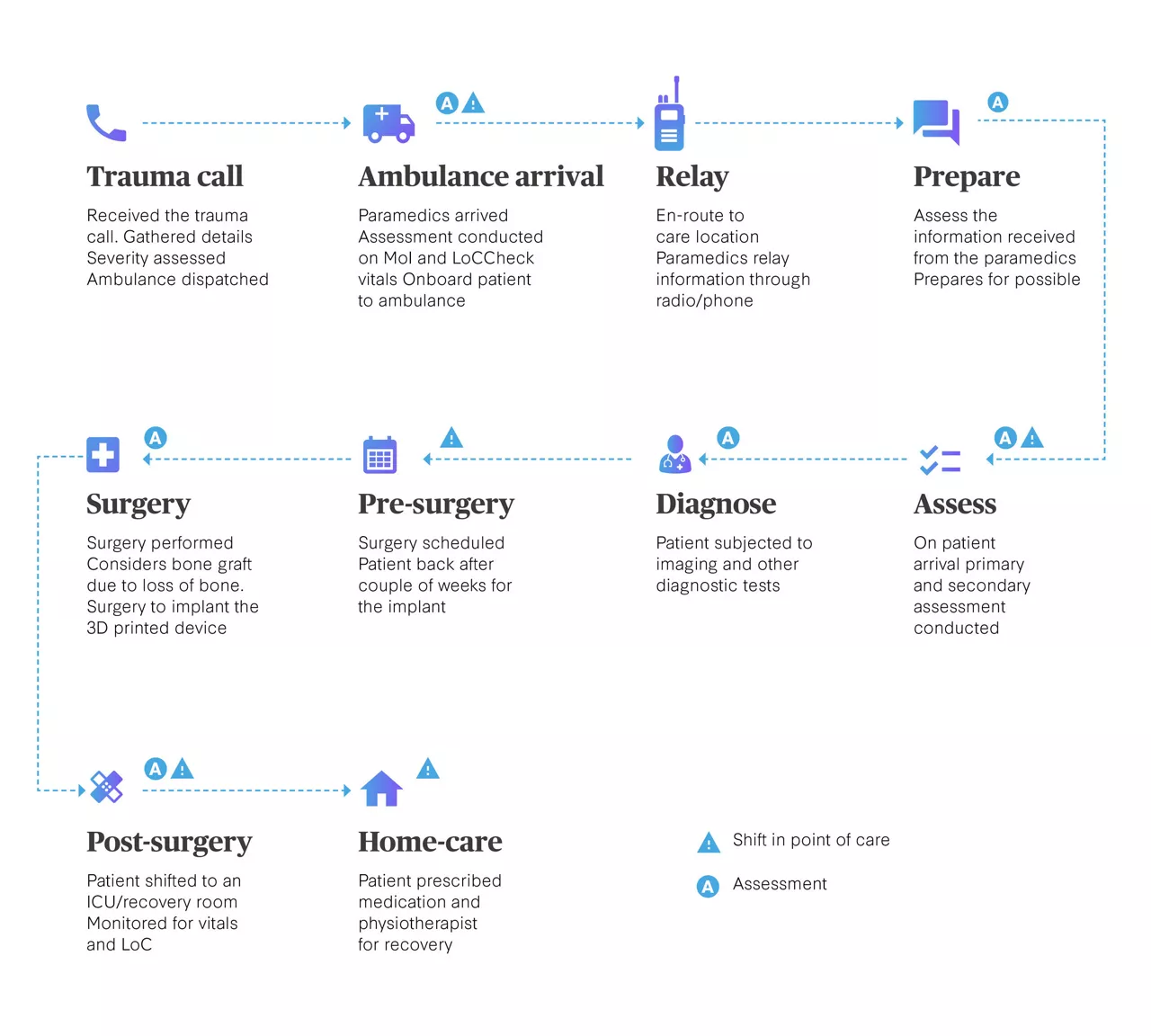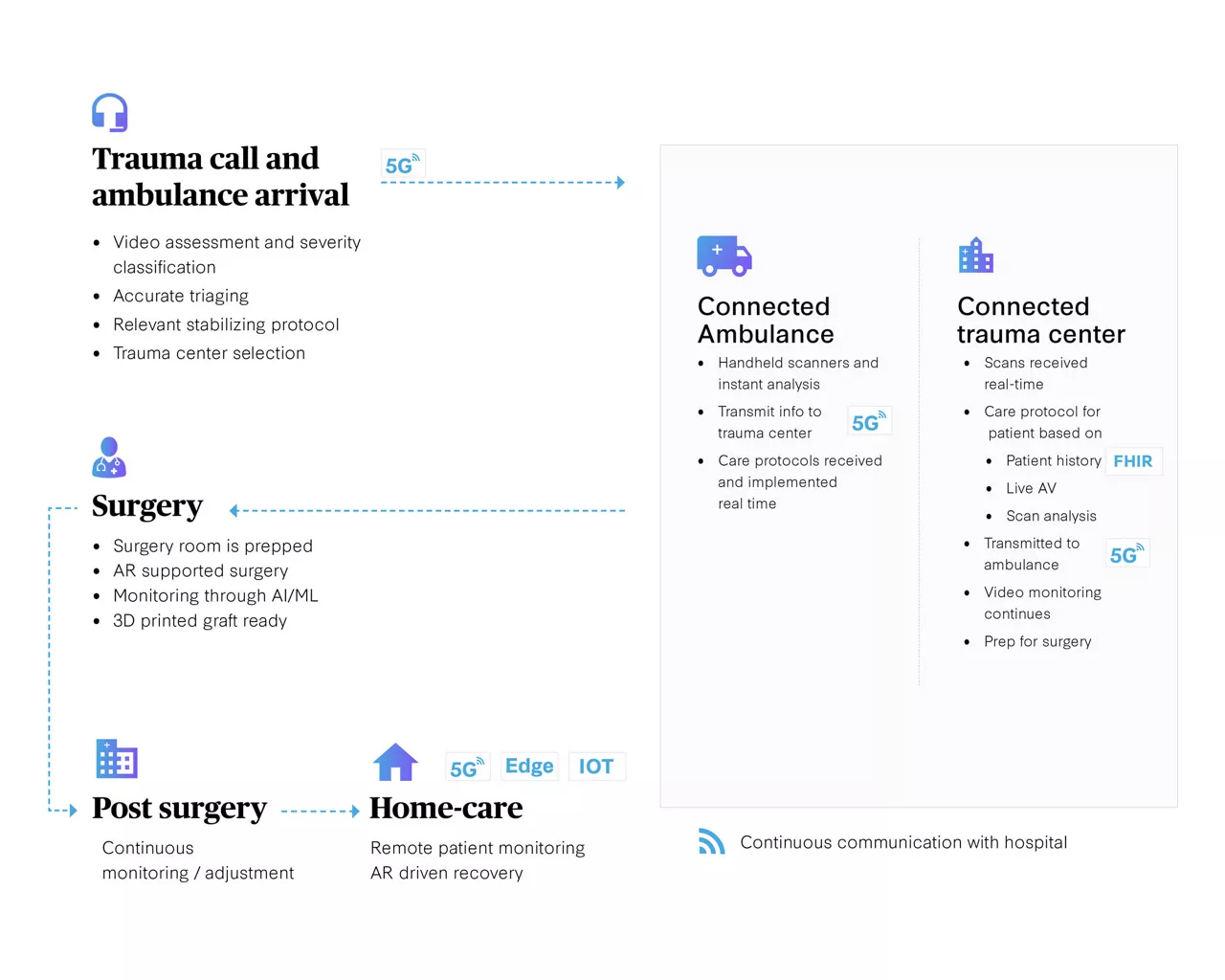Transforming injury-related trauma management with 5G
Senior Director, Technology, Virtusa
Injury is the 4th leading cause of death in the US. Trauma accounts for more years of productive life lost than any other illness.
Trauma is potentially a long-lasting negative impact on both the physical and mental health of an individual. Accidents, injuries, drowning, poisoning, burns, assault, and violence-related injuries are some of the adverse experiences that increase the lifelong risk for serious health problems. To add to this, the trauma from a disability is a global health concern. Time plays a crucial role in injury management. Each second counts in deciding if a person involved in an incident, like a leg crushed under rubble, gets to save every injured leg or not, and at times, time-lapse between the injury and the treatment defines life and death. It is estimated that 52 million accidental injuries killed 107,000, temporarily disabled over 10 million, and permanently impaired 400,000 Americans at the cost of $18 billion (approx).
Challenges faced in the trauma care journey
The healthcare ecosystem faces numerous challenges in infrastructure, data gathering and processing, connectivity, precision, and real-time monitoring. Under such circumstances, paramedics brief the emergency doctors to do their best and prevent worsening of the trauma with static SOPs and leave the treatment to ED clinicians once the ambulance arrives at the hospital. This leads to a delay in the commencement of trauma recovery, create inefficiencies due to hand over time, and shift to the correct wards resulting in an irreversible loss.
Breakdowns or mismanagement in care can occur due to:
- Communication breakdowns: It is difficult to acknowledge the patient's condition with the lack of digital capability in the ambulance. Overall management plan or priority of tasks is not conveyed clearly by the response or medical team. Identifying appropriate stabilization protocol and observing the same is essential as the transport time can range between 1-2 hours. 20% of trauma death are preventable with optimal emergency and trauma care
- Lack in interoperability: Each trauma care patient is unique. Not just in terms of the injury, they have suffered but also in terms of their underlying condition. Valuable information regarding pre-existing conditions, current medication, and other vital information need to be considered to create the trauma management protocol. However, this is not possible due to a lack of real-time data access of EMR records and non-existent piping to the patient's socio-economic-behavioral data, providing the holistic patient view.
- Inaccurate preliminary diagnosis: Instant responses and less connectivity make it challenging to rightly recognize the trauma, anticipate urgent needs, and modify the care system for patients. Lack of connected facilities, cameras, and sensors increases the risk of mistakes. Secondary transfers due to inaccurate triaging or severity classification and delay in imaging/diagnostics could increase surgery time by 2 hours.
- Workforce management problem: It is unrealistic to expect all staff to be experts in trauma injuries due to worsening conditions during transport. This leads to potential mismatch and non-streamline trauma management. Lack of connected solutions limits the ability to assemble the right staff and equip them to deliver the required care. The median time from emergency call to surgery averaged at 4 hours 37 minutes.
- Technology under-utilization in trauma management: Injuries need long recovery times and more personalized therapy. Lack of IoT devices fails to analyze the patient's current condition, and lack of communication fails to alert anomalies, delaying rapid responses and prevent exacerbation.

How can Edge Computing and 5G help?
Accurate assessments and continuous monitoring of the injury saves crucial time and prevents deterioration. It highlights a need to analyze multiple data sources to ensure the patient reaches the right care center, receives the right care, and recovers well post-surgery.
Point-of-care imaging devices are driven by edge computing with algorithms continuously improving by virtue of Machine Learning. The image capture elements of these imaging devices have undergone tremendous improvement that prevents the loss of fine details. The hardware required to detect the slightest anomaly with the crystal clear, distortion-free high-resolution lenses and the computers powering the device have become faster, smaller, and highly efficient. All these elements together provide a form factor and usability that is highly conducive to determining efficient care-in-motion.
5G can help overcome the challenges with real-time communication, Virtual Reality (VR)/video calling set-up, and immediate availability of onboarding facility into an ambulance. 5G allows the teams to accurately share the patient's condition gathered through IoT devices and perform analysis of the data at the edge to guide the paramedics and medical team to an accurate assessment. It can also relay tests such as ultrasound, x-ray, and even an MRI through portable devices equipped in the ambulance. All the real-time information received allows the medical team to prepare the treatment plan and assemble the right staff required to treat the patient on arrival, ensuring that proper treatment is delivered without losing time.
The whole solution works interoperably with all existing workflows, thereby eliminating omission errors and commission when transferring information from one system to another, thereby increasing efficiency and improving quality. All relevant information will always be accurate in all systems holding the patient information, including the EMRs, thereby driving optimal outcomes during recovery. Global value is also unlocked by advancing trauma care driven by research utilizing the rich data now available from every trauma event managed.
Latest advancements in surgeries such as Robotic surgeries, AR-supported surgery, and AI/ML solutions are set to gain speed with 5G and edge computing. Post-surgery, real-time information sharing can help monitor patient recovery, and allow the medical team to intervene in real-time and with high effectiveness.
5G can transform the system with connected ambulance and trauma center

The future of 5G in trauma care
Each year in the United States, trauma accounts for 37 million emergency department visits and 2.6 million hospital admissions. It is an economic burden of $406 billion per year, marking a considerable loss. Under such conditions, Edge Computing and 5G provide the much-needed communication technology that adds reliability, scale, and speed to hospital systems. Thus, enabling faster access to care, reduced recovery time, and lower mortality rate. Combining 5G and leading edge-technologies healthcare ecosystem creates an opportunity to transform trauma patient care.
Shankar Ram Swaminathan
Senior Director, Technology, Virtusa
Shankar is the AppDev solutions head for healthcare, life sciences, and insurance business units at Virtusa. As a technology leader, Shankar provides leadership for developing an innovative, robust, and secure information technology environment for healthcare and life sciences customers. He has a diverse set of experience in firmware development, designing, and deploying cloud-scale high-performance architectures. His knowledge and expertise have proved invaluable to the company.
Subscribe to keep up-to-date with recent industry developments including industry insights and innovative solution capabilities
Unlock the potential of AI/ML-powered solutions